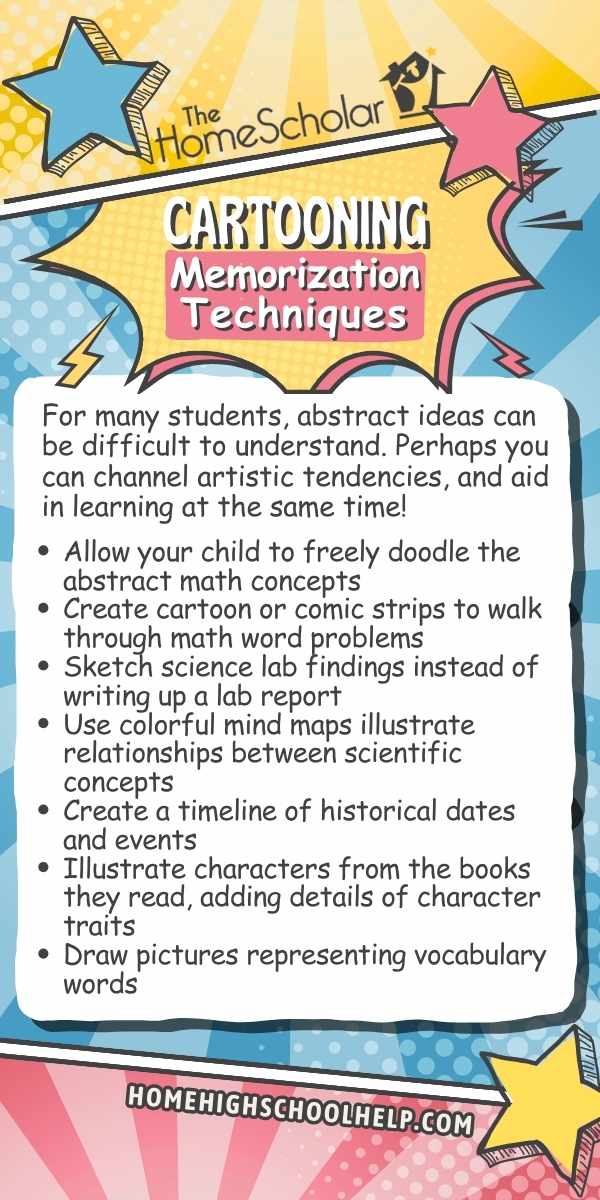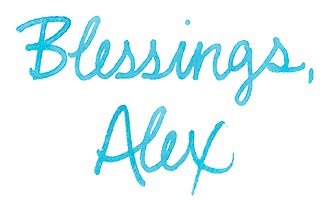Cartooning Memorization Techniques
If your child can't sit still through a lesson, if you have journals jam-packed with little doodles, if every spare scrap of paper has a tiny drawing on it, this is for you. Sounds like you've got a cartoony child on your hands! When your child has an unbridled need to draw and doodle instead of doing schoolwork, it can make you want to BIF! them on the head! But, if you understand how to channel their wild artist spirit, you can encourage them in their academics without sacrificing their art. Plus, your child can get in some great study and memorization techniques as well. Here are my top suggestions on how to incorporate cartooning into your homeschool!
Math
- Concept Illustrations: Allow your child to freely doodle the abstract math concepts, representing them with graphs, geometric shapes, or equations in visual form. Remember there is no wrong answer in art.
- Story Problems: Create cartoon or comic strips to walk through the word problems. The characters will "solve" the problem step by step. Encourage your child to add as many cartoony onomatopoeias as their heart desires.
- Math Journaling: Showing your work is important in mathematics, especially as the student becomes more advanced. Let them show their work as artistically as they want, expressing their problem-solving through doodles. If they continue to attain mastery over every concept, they are still learning.
Science
- Visual Lab Notes: After completing a lab or experiment, your child can sketch their findings instead of writing up a lab report or paper. Let them doodle the cells, plants, or steps in the chemical reaction.
- Concept Maps: Use colorful mind maps or doodles to show relationships between different scientific concepts. This will look different for every single child, and maybe for every single scientific concept.
- Science Comics: Create comics explaining scientific theories (like creation, photosynthesis, the water cycle, or gravity). Each one can contain their favorite comic book heroes or their own cartoon characters. Even superheroes live within the rules of the water cycle.
Seeing the processes and experiments laid out visually can help your student memorize and retain the information better. The effort and act of drawing it all out is like repeating the information over and over again until it sticks.
History
- Timelines with Drawings: Create a timeline of all the standard dates or events your child will be studying through the year. Your child can follow behind you to create a doodle or cartoon for every significant event they studied throughout the year.
- Character Sketches: Draw political figures, warriors, or inventors and include text bubbles with their achievements. How would George Washington look in your student's unique art style, I wonder?
- Historic Comic Strips: Recreate important moments in history through a comic strip format. Include as much real dialogue as possible. Famous historical lines are the most fun to recreate through art. Quotes like, "A Republic, Madam, if you can keep it." Or "I may walk slowly but I never walk backwards." Or more stirring, "The victor will never be asked if he told the truth". These can help make the historical scene more real to your student. [Bonus points in the comments if you know who said these lines!!]
English
- Literary Doodles: Encourage doodling while reading or listening to an audio book, where your student sketches scenes, characters, or themes from the assigned books. You might even be able to substitute the occasional essay for a detailed drawing or artful retelling of events from the story.
- Character Profiles: Have your student illustrate characters from the books they read, adding details to help understand their traits. Perhaps think of it like a gallery of characters, each in a frame (physical or doodled), and each with their own detailed biography.
- Creative Writing Prompts: Use cartoons to inspire short stories, where your student draws an initial scene and then writes about it. The more detailed the scene, the more detailed the writing can be! This method can be used to help the student put themself in place of the characters, making the story more real and meaningful.
Much of high school literature is analyzing the plot, the characters, and the hidden meanings behind chosen phrases. Sketching out these themes and elements can make literature more tangible for your student and help them keep the narrative straight. These pieces are also fantastic to keep for your homeschool records as included works.
Foreign Language
- Vocabulary Comics: Allow your student to create comics where characters speak in the target language, helping reinforce vocabulary and sentence structures. Writing in the studied language is an important skill that can sometimes be overlooked in pursuit of speaking fluently. This method will consistently incorporate that skill.
- Flashcard Art: Draw pictures representing vocabulary words, especially for nouns, verbs, and adjectives. You can use these as typical flashcards, or tape them around the house with the corresponding noun or object for practice throughout the day.
Inquiring minds would love to know in the comments!!
When you subscribe to the blog, we will send you an e-mail when there are new updates on the site so you wouldn't miss them.

 Login
Login









.jpg)

Comments